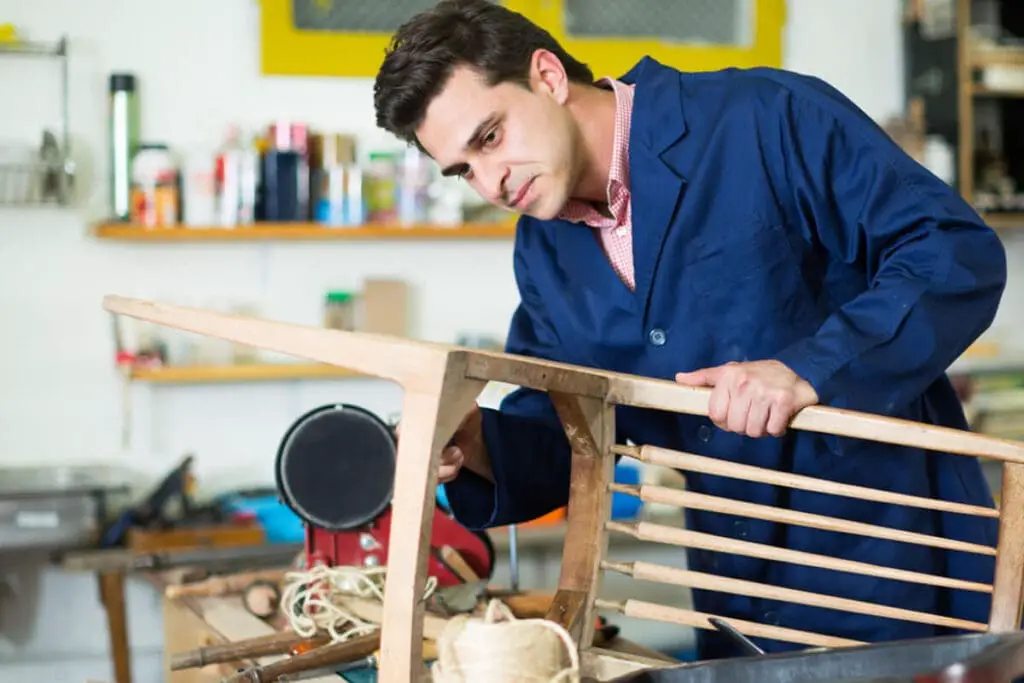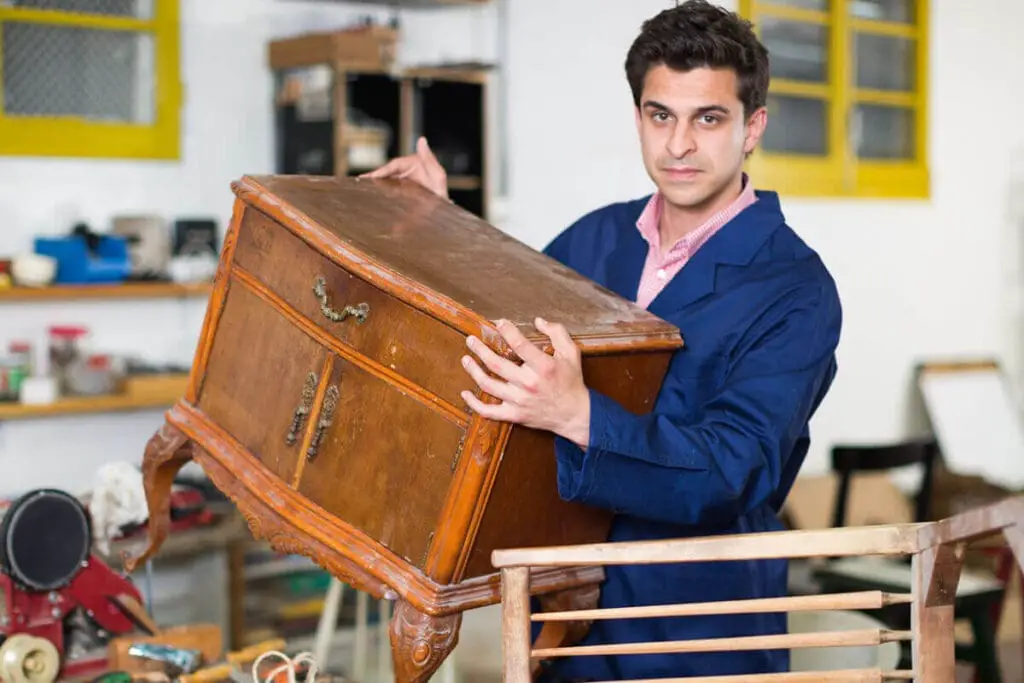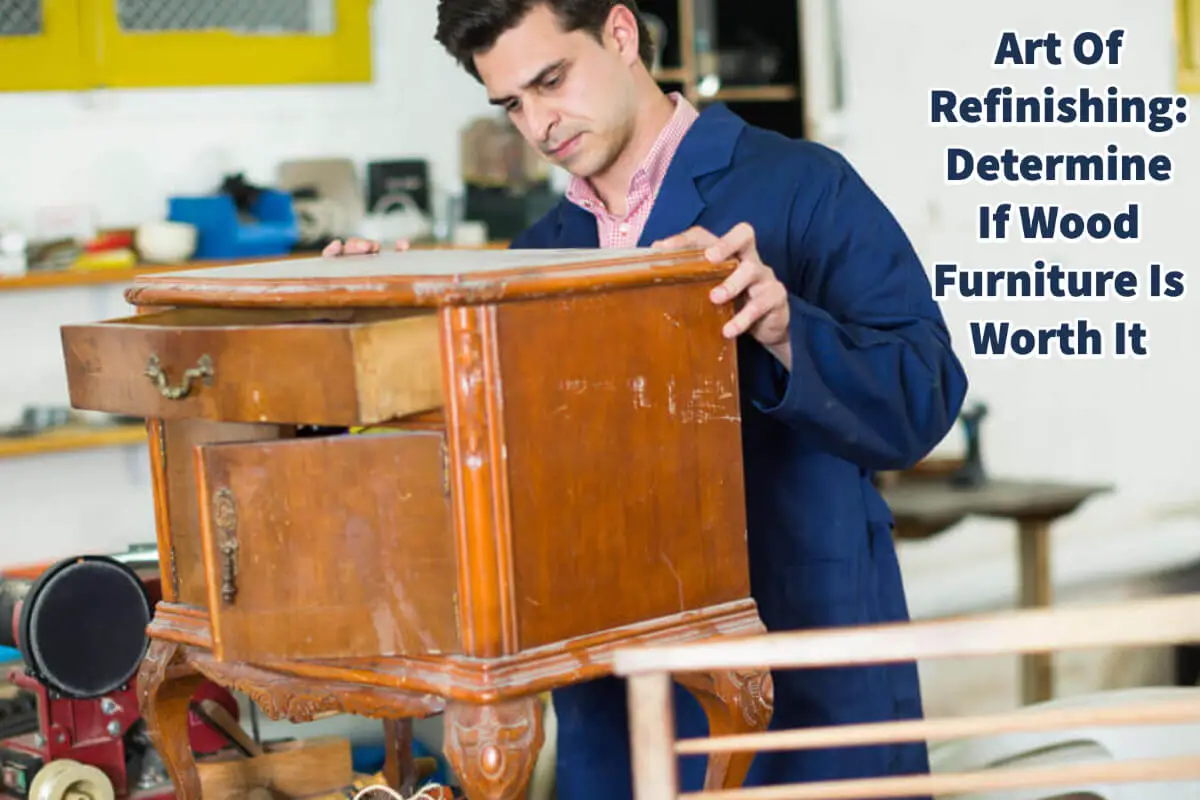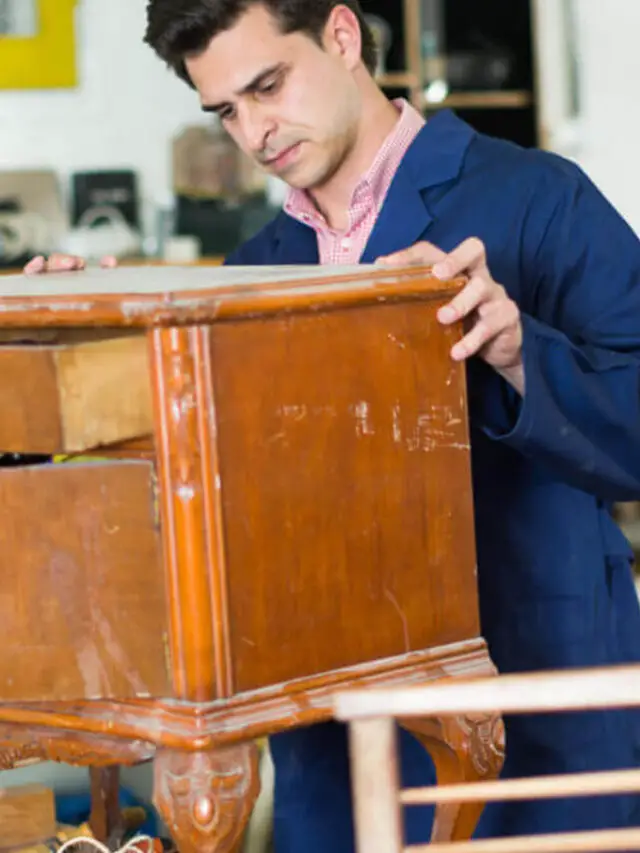Many people love to go to flea markets or find old pieces of furniture to refinish or paint. But the truth is that not all wood furniture, especially solid wood is worth the time, effort, and money to refinish it.
Not all solid wood, wood, or even old pieces of furniture is worth the time, effort, and money to refinish the piece of furniture. Refinishing furniture, especially if you will do it yourself, is a long and sometimes complex process. We have outlined six areas to look at when you are looking to refinish a piece of furniture.
Table of Contents
- 6 Points To Consider When Looking To Refinish A Wood Furniture Piece
- Why Refinishing Furniture Is An Artful Decision?
- Related Content
6 Points To Consider When Looking To Refinish A Wood Furniture Piece
Preserving a piece of wooden furniture’s charm and integrity is no small feat; it is an art form that requires skill, understanding, and appreciation for its history.
Refinishing a piece, though seemingly straightforward, is a project that must be undertaken with caution and meticulous consideration. Not every piece warrants the time, effort, and cost of refinishing.
Read on as we give you some essential knowledge to make the most informed decision as to whether a furniture piece should be refinished.
Age Of The Furniture: A Timeless Indicator
Age plays a significant role in assessing a furniture piece’s worth for refinishing. Pre-1950s furniture pieces are typically made from solid wood, a feature that signifies craftsmanship and durability, making them valuable assets.
As the manufacturing process evolved during the 1950s and 1960s, materials like particle boards and other types of wood were introduced, altering the longevity and durability of the furniture.
An antique piece of solid wood may seem like an excellent candidate for refinishing, but be wary as the piece’s value could be compromised if the refinishing process fails.
The age of your furniture isn’t merely a number but a clue to its construction, history, and worth. So, if you have an old piece you are considering refinishing, do your homework or consult a professional before commencing the task.

Quality Of The Furniture: The Devil Is In The Details
The next factor to examine is the quality of the furniture. High-quality pieces typically showcase intricate manufacturing details, such as dovetail construction, evident in doors and drawers.
Dovetail joinery is a testament to a craftsman’s skill and attention to detail, indicating the piece’s potential worth. Other things to look at are the backside and whether the back has solid wood or a cheaper particle board.
On the flip side, a poorly constructed piece, though seemingly attractive, may not withstand the refinishing process or could not be worth the effort. Thus, inspect the furniture for quality signs before investing your time and resources in refinishing it.
Paint Condition: A Double-Edged Sword
One of the trickiest aspects of refinishing is dealing with painted furniture. Paint can hide many sins, from scratches and stains to deeper structural issues.
While stripping off old paint might seem like a way to breathe new life into a piece, it could also reveal problems that make refinishing more trouble than it’s worth.
Additionally, stripping paint is a labor-intensive task that requires specialized tools and safety precautions due to potentially hazardous materials in old paint. Hence, a painted piece of furniture should be evaluated cautiously before embarking on a refinishing journey.
Original Hardware And Details: Unaltered Beauty
Original hardware and details contribute significantly to a furniture piece’s authenticity and, therefore, its value. These features, such as handles, knobs, or decorative elements, reflect the era’s design aesthetics and the manufacturer’s signature style.
Preserving these original components during the refinishing process can enhance the piece’s appeal to collectors and antique enthusiasts, making the effort more worthwhile. Thoroughly examining these details is vital before making a decision.

Manufacturer’s Stamp: A Mark Of Quality
Look for the manufacturer’s stamp, typically found on the back, bottom, or inside drawers of furniture pieces. This mark can provide valuable information about the furniture’s origin and quality.
Renowned manufacturers’ stamps can significantly boost the furniture’s value, making the refinishing effort a sound investment.
However, if the manufacturer is unknown or has a dubious reputation, refinishing may not increase the piece’s value enough to justify the effort and cost. Therefore, a manufacturer’s stamp isn’t just a mark but a vital clue in determining whether to refinish a piece of furniture.
Evaluating The Overall Worth Of The Furniture: An Important Step
Before jumping into the refinishing process, evaluate the overall worth of the piece. Do some research to compare similar pieces in terms of age, manufacturer, style, and condition.
You can look at online marketplaces, antique dealers, or auction records to understand what your furniture might be worth.
Remember, its monetary worth doesn’t only determine the value of a piece. Personal attachment, sentimental value, or the piece’s fit with your interior decor could also dictate whether it’s worth refinishing.
Be sure to weigh all these essential factors before making your decision.
Why Refinishing Furniture Is An Artful Decision?
Refinishing a wooden furniture piece is an artful decision that goes beyond a mere DIY project. It carefully balances restoration and preservation, enhancing the aesthetic appeal and maintaining historical integrity.

Before refinishing a piece, consider its age, quality, paint condition, original details, and manufacturer’s stamp.
A keen understanding of these aspects will help you gauge the piece’s actual value and whether it’s worth the investment in terms of time, effort, and resources. Ultimately, the choice to refinish a furniture piece should come from a place of knowledge and appreciation for its potential beauty, usefulness, and historical significance.
Remember, not all furniture is suited for a makeover. Sometimes, the beauty of a piece lies in its age-worn look, the story it tells, and the history it carries within its grains. Refinishing a piece of furniture isn’t just about enhancing its appearance but about respectfully preserving its narrative while adding a chapter of your own.
Find out more about how Mondoro can help you create, develop, and manufacture excellent home decor and furniture products – don’t hesitate to contact me, Anita. Check out my email by clicking here or become a part of our community and join our newsletter by clicking here.
Mondoro gives out a FREE Lookbook to anyone interested. You can receive a copy of our latest Lookbook by clicking here.
Listen to our Podcast called Global Trade Gal. You can find it on all major podcast platforms. Try out listening to one of our podcasts by clicking here.
Subscribe to our Mondoro Company Limited YouTube Channel with great videos and information by clicking here.
Related Content
Designing Furniture – Material And 6 Things To Consider
To design a piece of furniture, you need to consider the ability of the person or manufacturer producing the furniture for you, particularly their quality and skillsets. You also need to consider the materials available to be used, the overall construction of the furniture piece, if it will be a K/D or non-K/D piece of furniture, and the finish and hardware of the furniture.
You can discover more by reading Designing Furniture – Material And 6 Things To Consider by clicking here.
What Are Somethings to Look At When Considering A Solid Wood Furniture Manufacturer?
One of the things we look at when we go into a new solid wood furniture manufacturer is in-house kiln wood drying. We also like to know if they understand how to join the wood correctly and have the equipment to do it. Also, if the manufacturer is in a hot and tropical climate, they have a dry room to help control the wood moisture levels. We like to work with factories that will cut and shape all the wood themselves and have in-house finishing facilities.
You can find out more by reading our blog on 5 Questions To Ask When Considering A Solid Wood Furniture Manufacturer by clicking here.
What About Recycled or Reclaimed Wood Furniture?
Reclaimed and recycled wood may seem the same, but they are not precisely the same. Recycled wood is wood that would have otherwise been discarded or not used. Wood is a naturally sustainable material as it can be regrown and replaced. There are a variety of furniture shapes and styles that can be used to make recycled pine furniture.
You can find out more by reading our blog on Recycled Pine Furniture, What You Need to Know by clicking here.



